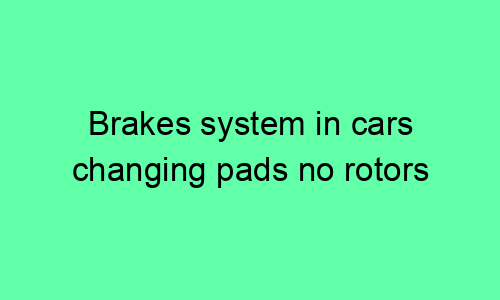Brakes System: Changing Pads No Rotors
Introduction
The brakes system in a car is one of the most important safety features. It allows you to slow down and stop the car, and it helps to keep you and your passengers safe. The brakes system consists of several components, including the brake pads, rotors, calipers, and master cylinder.
Brake pads are the part of the brakes system that comes into contact with the rotors and creates friction to slow down or stop the car. Brake pads are made of a hard material, such as ceramic or metal, and they are designed to withstand the high temperatures and friction that are created when braking. Brake rotors are the discs that the brake pads press against to slow down or stop the car. Brake rotors are made of a hard material, such as iron or steel, and they are designed to dissipate the heat that is created when braking.
Brake calipers are the components that hold the brake pads in place and apply pressure to the brake rotors. Brake calipers are made of a strong material, such as aluminum or steel, and they are designed to withstand the high forces that are created when braking. The master cylinder is the component that sends brake fluid to the brake calipers. The master cylinder is made of a strong material, such as aluminum or steel, and it is designed to withstand the high pressures that are created when braking.
Changing Brake Pads
Brake pads should be changed when they are worn down to a thickness of about 1/4 inch. If the brake pads are worn down too far, they can damage the brake rotors and other components of the brakes system. Changing brake pads is a relatively simple task that can be done in about 30 minutes.
To change the brake pads, you will need the following tools:
* A jack
* A jack stand
* A lug wrench
* A socket wrench
* A torque wrench
* A new set of brake pads
Once you have the necessary tools, follow these steps to change the brake pads:
1. Park the car on a level surface and engage the parking brake.
2. Loosen the lug nuts on the wheel that you are going to be changing the brake pads on.
3. Use the jack to raise the car and place the jack stand under the car.
4. Remove the lug nuts and take off the wheel.
5. Use the socket wrench to remove the caliper bolts.
6. Remove the caliper and hang it from the suspension with a bungee cord.
7. Remove the old brake pads from the caliper.
8. Install the new brake pads in the caliper.
9. Reinstall the caliper and tighten the caliper bolts.
10. Reinstall the wheel and tighten the lug nuts.
11. Repeat steps 2-10 for the other wheel.
Once you have changed the brake pads, pump the brake pedal several times to build up pressure in the brakes system. Then, test the brakes by driving the car at a low speed and applying the brakes. If the brakes feel spongy or if the car does not stop as quickly as it should, there may be a problem with the brakes system. In this case, you should take the car to a mechanic to have it inspected.
Changing Brake Rotors
Brake rotors should be changed when they are warped or cracked. Warped brake rotors can cause the car to vibrate when braking, and cracked brake rotors can cause the brakes to fail. Changing brake rotors is a more complex task than changing brake pads, and it should be done by a mechanic.
To change the brake rotors, the mechanic will need to remove the wheel, caliper, and brake pads. Then, the mechanic will use a special tool to remove the brake rotor from the hub. The mechanic will then install the new brake rotor and reassemble the brakes system.
Once the brake rotors have been changed, the mechanic will pump the brake pedal several times to build up pressure in the brakes system. Then, the mechanic will test the brakes by driving the car at a low speed and applying the brakes. If the brakes feel spongy or if the car does not stop as quickly as it should, there may be a problem with the brakes system. In this case, the mechanic will need to inspect the brakes system to determine the cause of the problem.
Conclusion
The brakes system in a car is a critical safety feature. It is important to keep the brakes system in good working condition by regularly changing the brake pads and rotors. Changing brake pads is a relatively simple task that can be done in about 30 minutes. Changing brake rotors is a more complex task that should be done by a mechanic.
By following the steps in this article, you can keep your brakes system in good working condition and help to ensure your safety and the safety of your passengers.






